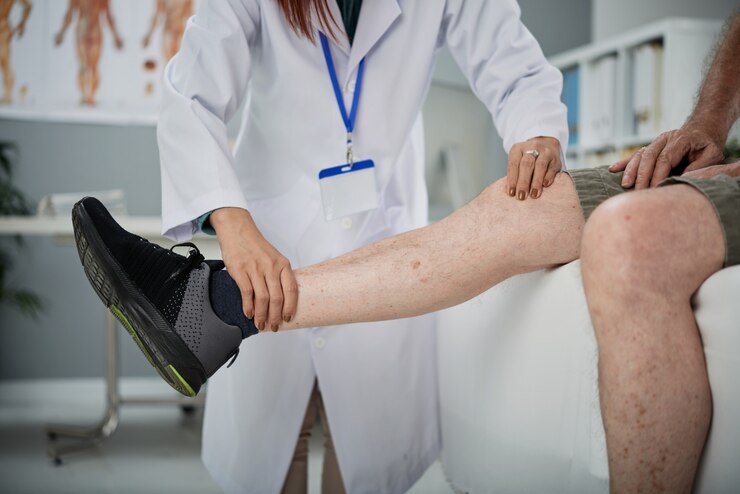Splinter hemorrhages are a peculiar fingernail abnormality characterized by the appearance of red streaks resembling splinters beneath the nail surface. These streaks typically run longitudinally along the nail bed. The condition arises from the swelling or leakage of small blood vessels within the nail bed, often accompanied by the formation of microemboli, tiny clots within the capillaries.
Visually, splinter hemorrhages may resemble thin, reddish-brown lines, resembling splinters trapped beneath the nail. Despite their appearance, these hemorrhages are not caused by physical objects but rather by underlying physiological factors. Understanding these nuances is crucial for accurate diagnosis and appropriate management of the condition.

Causes of Splinter Hemorrhages
– Trauma-related Causes
Splinter hemorrhages often stem from trauma inflicted upon the nail or surrounding tissue. This trauma can disrupt the integrity of the blood vessels within the nail bed, leading to the characteristic appearance of hemorrhagic streaks. Common traumatic events include accidents such as slamming fingers in doors or forcefully hitting the nail against hard surfaces.
– Medical Conditions
Various underlying medical conditions can predispose individuals to splinter hemorrhages. These conditions affect the body’s vascular system or immune response, contributing to the development of hemorrhagic nail abnormalities. An overview of medical conditions associated with splinter hemorrhages includes infectious endocarditis, nail psoriasis, antiphospholipid syndrome, IV drug abuse, systemic lupus erythematosus, and rheumatic heart disease. Each of these conditions presents unique pathophysiological mechanisms that may manifest as splinter hemorrhages.
– Medication Related Causes
While relatively rare, certain medications have been linked to the occurrence of splinter hemorrhages. These instances typically involve drugs that affect the body’s coagulation system or vascular function. Aspirin, certain chemotherapy agents, and anticoagulants like warfarin are among the medications occasionally associated with splinter hemorrhages. While the occurrence of medication-induced splinter hemorrhages is uncommon, it is essential to be aware of the potential side effects of these medications and monitor for any adverse reactions.
Treatment Approaches
– Trauma induced Splinter Hemorrhages
In cases where splinter hemorrhages result from trauma, the body’s natural healing process typically resolves the condition over time. The duration of healing varies but can take approximately three to four months for the hemorrhages to disappear completely. However, if the trauma causes significant damage to the nail or nail bed, medical intervention may be necessary. Indications for treatment include severe pain, nail deformities, or signs of infection.
– Splinter Hemorrhages due to Medical Conditions
Addressing splinter hemorrhages associated with underlying medical conditions involves treating the root cause of the condition. For example, if the hemorrhages are linked to infectious endocarditis or nail psoriasis, targeted therapies aimed at managing these conditions may help alleviate the hemorrhagic nail abnormalities. Treatment options may include antibiotics for infectious conditions or immunosuppressants for autoimmune disorders. The specific treatment plan will depend on the underlying medical condition and should be determined in consultation with a healthcare provider.
– Medication-induced Splinter Hemorrhages
When splinter hemorrhages are attributed to medication use, a collaborative approach with a healthcare provider is essential. It is crucial to discuss any concerns or adverse reactions with the prescribing physician. Depending on the severity of the hemorrhages and the necessity of the medication, adjustments may be made to the treatment regimen. However, it is essential never to discontinue medication abruptly without medical guidance, as this can lead to adverse effects or exacerbate underlying conditions. Monitoring the progression of splinter hemorrhages and communicating with healthcare providers can help manage medication-induced nail abnormalities effectively.
General Treatment Options
– Alleviating Discomfort with Cold Compress
Applying a cold compress to the affected nail can help alleviate discomfort associated with splinter hemorrhages. Cold therapy helps reduce inflammation and numbs the area, providing temporary relief from pain or irritation. It is recommended to apply the cold compress for 15 to 20 minutes at a time, with a cloth barrier between the cold pack and the skin to prevent frostbite or skin damage.
– Over The Counter Pain Medication Recommendations
Over-the-counter pain medications such as acetaminophen or ibuprofen may be recommended to manage pain and discomfort caused by splinter hemorrhages. These medications can help reduce inflammation and alleviate mild to moderate pain associated with nail abnormalities. It is important to follow the recommended dosage instructions and consult a healthcare professional if pain persists or worsens.
– Preventive Measures for the Affected Nail
Taking preventive measures can help protect the affected nail and minimize the risk of further trauma or damage. Avoiding activities that may exacerbate the condition, such as excessive nail biting or picking, can promote healing and prevent recurrence of splinter hemorrhages. Additionally, maintaining good nail hygiene, keeping nails trimmed and clean, and wearing protective gloves when engaging in activities that may pose a risk of injury to the nails can help prevent future occurrences of splinter hemorrhages.
Prognosis and Outlook
– Factors Affecting Healing Time
Several factors can influence the healing time of splinter hemorrhages, including the underlying cause, the severity of the condition, and the individual’s overall health. In cases where splinter hemorrhages result from trauma, the body’s natural healing process typically resolves the condition over time, with complete resolution often taking three to four months. However, if splinter hemorrhages are associated with underlying medical conditions or medication use, the prognosis may vary depending on the effectiveness of treatment and management strategies. It is essential to monitor the progression of the condition and follow up with a healthcare provider for ongoing assessment and guidance.
– Importance of Seeking Professional Advice
Seeking professional medical advice is crucial for the accurate diagnosis and management of splinter hemorrhages. A healthcare provider can assess the underlying cause of the condition, recommend appropriate treatment options, and monitor the progression of the condition over time. Additionally, healthcare providers can provide guidance on preventive measures to minimize the risk of recurrence and address any concerns or complications that may arise. Prompt intervention and ongoing medical care can help optimize outcomes and ensure the best possible prognosis for individuals affected by splinter hemorrhages.
Conclusion
In conclusion, splinter hemorrhages, characterized by red streaks resembling splinters beneath the nail surface, can stem from various causes including trauma, underlying medical conditions, or medication use. While trauma-related hemorrhages often resolve on their own over time, those associated with medical conditions or medications may necessitate targeted treatment. Cold compresses and over-the-counter pain medications can provide relief from discomfort, while preventive measures aim to protect the affected nail from further injury.
Factors such as the underlying cause and individual health status influence the prognosis of splinter hemorrhages. Seeking professional medical advice is paramount for accurate diagnosis and personalized treatment recommendations. Collaboration with healthcare providers ensures tailored care, monitoring of the condition’s progression, and timely intervention to address any complications. Through professional guidance, individuals can effectively manage splinter hemorrhages, minimizing their impact on overall health and well-being.



